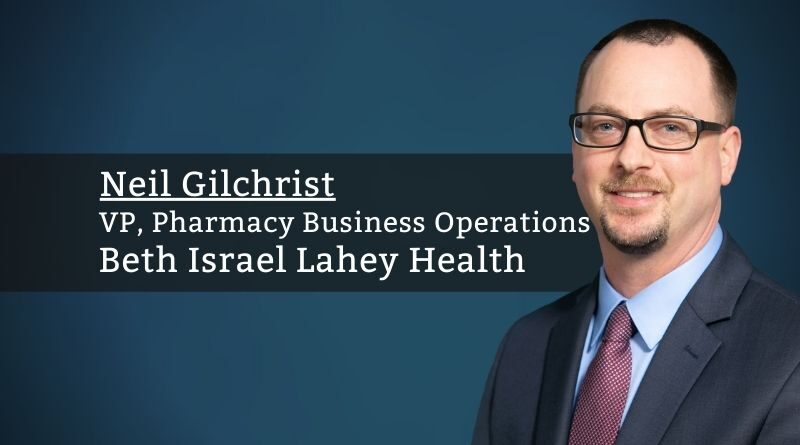Leading through Challenging Times
By Neil Gilchrist, PharmD, MBA, BCPS, DPLA, VP, Pharmacy Business Operations, Beth Israel Lahey Health
In January 2020, the center for disease control (CDC) reported the first case of the novel coronavirus. Over the next several weeks, it would become evident that this virus was spreading quickly across the country and would need to be managed by many health care systems. We have been here before with wide-scale events from infectious diseases such as H1N1 influenza in 2009 to a supply chain crisis with IV Fluids when Hurricane Maria hit Puerto Rico in 2018. The problem or challenge was large enough to align all stakeholders to work together, collaborate and identify shared goals.
The COVID-19 pandemic is a strong example where all priorities shifted to focus on the response plan.
As pharmacy leaders, most of the challenges we will need to manage will be less clear about the end result or alignment of stakeholders. Therefore, it would be prudent to look at the tactics and tools that were successful during the COVID-19 pandemic and apply these to future events. Looking forward, we are in a challenging position across the country as health system pharmacy leaders will need to manage an unprecedented supply chain challenge, with record-level inflation prices and hospital and health-system financial shortfalls. It will be critical to lead our teams through these uncertain challenges and help them identify how we can work together to accomplish shared goals.
Strategic planning is key
We must plan if we do not want to leave the results or outcome to chance. This can be a formal process with a strategic retreat or informal in smaller team meetings. The important point is that you must define for your team what is important to work on over the next 9-12 months based on the challenges that you and your leadership team see ahead. There will be a strong influence from your organizational strategic goals; however, pharmacy department-specific goals will come from the pharmacy management team. In addition, many strategic plans will need to be extended to 2-3 years at a minimum to forecast reimbursement changes, regulatory updates and capital projects.
Within your strategic plan process, the team should consider elements of strength where your team is performing well and areas needed for improvement. After defining these internal factors, consider external to your department and organization opportunities to grow your services and business while considering threats to your pharmacy services. An example of a threat listed above is how your team will prepare for the current supply chain challenges. This tool, referred to as SWOT analysis, assists the team in formally evaluating the areas of strengths, weaknesses, opportunities and threats. This is necessary for leading your team through challenging times and incorporating it into the strategic planning process.
Communication, communication, communication
Once you have developed a strategy and vision, it is essential to communicate this plan to your team. During the height of the COVID-19 pandemic, many leaders used virtual town halls to connect with their large teams and remote teams. Consider the tools you will need to spread the information in your strategic plan including emails, town hall, staff meetings, 1:1 meetings, dashboards and reports. By sharing the department goals, you will empower your team members to participate in meeting these goals and ultimately, celebrate your successes together. This process will also allow emerging leaders to shine by taking on projects that may not be directly in their day-to-day work. Finally, for future challenges, it will be important to identify these emerging leaders and incorporate them into succession planning.
“Catchball”
The lean concept of information sharing between leaders and team members in a continuous cycle can help be an early signal of both success and new challenges that need to be managed. Ensure in the process of managing challenging times at all levels of management, there are established recurring team and individual meetings to allow for information sharing both to the team members and the managers. This catchball system will be beneficial for all aspects of the strategic plan.
One common tool in catchball systems is establishing a dashboard that tracks key performance metrics. The performance of the metrics can be incorporated into meetings as a talking point and then discussions on why these are either performing to plan or additional focus need to be provided.
Expect new challenges
Healthcare is an ever-changing environment with many stakeholders, suppliers, inputs and beyond. While pharmacy leaders must navigate challenging times with a robust strategic plan and communication platform, expect new challenges to arise that may not fit into the original plan. As leaders, we must evaluate the situation and determine if this new challenge requires an identified owner or resource on your team to manage or if you will need to shift your priorities to manage this new challenge. The COVID-19 pandemic is a strong example where all priorities shifted to focus on the response plan. Teams canceled all non-essential meetings and staff assisted in non-traditional roles to manage the priority of response. The path forward will not always be direct.
Strategic goals and results will be top of mind during challenging times, but as a final note, it is essential to connect back to your management team and front-line staff to ensure they have the resources and support to be successful. Recognizing that stressful times impact team members differently and personal challenges outside work can be an additive effect to performance and stress. As mentioned in the communication plan, incorporating wellness checks into 1:1 meetings with team members can be useful in navigating team resilience and wellness.
Communicate frequently, be organized and support your teams knowing that together you can navigate any challenging times as a team.



